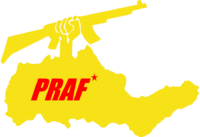People's Revolutionary Armed Forces
 Logo | |
| Founded | 1733 AN |
|---|---|
| Active | 1733 AN - Present |
| Type | Terrorist organization |
| Leaders | Emil Pachad |
| Notable Attacks | |
| Designated as a terrorist group by |
|
The People's Revolutionary Armed Forces (Commonspeak: Folks Revolusonarë Armed Förses) is an Aerlan terrorist organization founded in 1733 AN by Emil Pachad as an armed breakaway of the People's Revolutionary Communist Party.
History
In early 1732 AN, after a particularly rousing anti-Government speech at the Auburn Arts College, PRCPA leader Constantine Veracek was arrested and charged sedition, receiving a 20 year prison sentence. After Veracek's arrest the vice-chairmen of the party, James Lewiston, took charge. Lewiston was much less of a radical then Veracek was, preferring a legitimate rise to power via democratic means. This caused a rift in the party, with many of the more radical members holding a strong distaste for Lewiston's moderate policies. The chair of the Auburn Branch of the party, Emil Pachad, responded to the arrest by creating an armed breakaway faction to "create a real armed struggle against the oppressive regime of the traitorous Noursala bourgeois."
Attacks
Fountain Plaza bombing
Auburn NationalBank Robbery
In early 1734.4 AN, two masked gunmen attempted to stage a robbery of an Auburn branch of NationalBank. The two gunmen walked into the bank and fired several rounds into the air and ordered the occupants of the bank to the ground. They then forced the bank manager, at gunpoint, to open the vault. Once inside, they proceeded to steal roughly Ƒ550,000 in bills. Unbeknownst to the robbers, hidden within the stacks of cash were several dye packs that exploded when the gunmen left the bank, rendering the cash unusable.
After dumping their now useless cash in the bank's parking lot, the robbers were then engaged in an hour-long shootout with Auburn Police. In the end, one gunman was killed and another one surrendered to law enforcement. Although police initially believed this was a simple bank robbery, closer inspection of the dead gunman's jacket revealed a PRAF patch. The PRAF would later claim responsibility for the attack in a post to their website (of which could only be accessed by the use of proxies to bypass censorship by the country's ISPs).